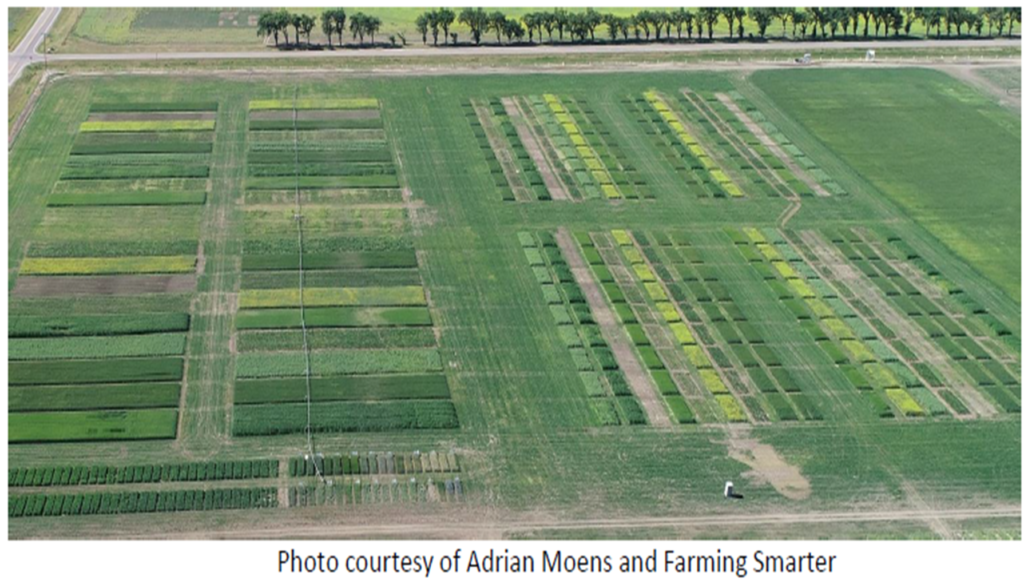
Features
Diseases
Research
Top Crop Summit
Top Crop Summit series: Crop rotation impacts Fusarium head blight
March 22, 2024 By Bruce Barker
 Left is the first year of the second experiment in 2019 at Lethbridge; right is the second year of the first experiment in 2019.
Left is the first year of the second experiment in 2019 at Lethbridge; right is the second year of the first experiment in 2019. Maria Alejandra Ovido-Ludena is a research assistant in cereal and flax pathology at the University of Saskatchewan. During the Top Crop Summit on Feb. 27-28 in Saskatoon, she discussed the results of a recent study aimed at determining the effect of multiple host and non-host crops in a planned sequence on FHB severity of bread or durum wheat and barley.
For management of Fusarium head blight (FHB), recommended practices include using cereals with varietal resistance, seeding early, using disease forecasts to guide fungicide application and having diverse crop rotations with non-host crops.
Host crops for FHB include cereal crops such as wheat, durum, barley, oat, maize and canary seed. Non-host crops include canola, flax, soybean, pea, lentil, dry bean, hemp and quinoa.
Two research projects were conducted at five locations across the Prairies to investigate the impact of crop rotation on FHB. The research objectives were to reduce the incidence and severity of FHB of cereals by including a diverse crop sequence with host and non-host crops in durum, bread wheat and barley. The first experiment ran from 2018 through 2020, and the second from 2020 to 2022.
Durum and bread wheat rotations were conducted at an irrigated site in Lethbridge, Alta., and dryland sites in Saskatoon, Sask., and Brandon, Man. Barley sites were at Indian Head in both experiments and Melfort, Sask., in only the first experiment.
In the first year of each experiment, strips of wheat, barley, canola, pea and maize were seeded. At some sites, oat, canary seed, lentil, hemp, dry bean, soybean and flax were also included in the crop rotations. In the second year, these same crops were seeded perpendicular to the first-year strips. In the third year, all plots were cropped to either wheat or barley.
The effect of crop rotation on FHB was measured by the presence and severity of FHB and leaf spot diseases, the frequency of the pathogenic Fusarium spp. on cereal kernels, and yield and quality parameters.
The results differed by site, with the FHB index (incidence x severity) being less than 0.5 per cent in Alberta and Manitoba in 2022. However, at Saskatoon in 2022, the FHB index of durum was greater than 26 per cent on maize-maize-durum, maize-canary seed-durum and maize-pea-durum rotations. When flax was included in the rotation, the FHB index of durum was less than 14 per cent.
At Lethbridge, nine different crops were included in the experiment, including durum, hard red spring wheat, barley, maize, canola, pea, dry bean, quinoa and hemp. The frequency of Fusarium spp. isolated from durum was greater than 22 per cent on pea-maize-durum, pea-pea-durum, hemp-pea-durum and hemp-hemp-durum rotations. Despite this, hemp and quinoa stubble were not well established at the site, and further research is needed with these novel crops. The frequency of Fusarium spp. was less than 10 per cent with canola in the rotation.
FHB index on barley was impacted only by the previous year’s 2021 stubble. At Indian Head in 2022, barley grown on canary seed stubble had greater than 12 per cent Fusarium spp. identified on barley kernels. Hemp and quinoa stubble were also poor crop rotation choices, while the frequency of Fusarium spp. following pea and soybean was less than five per cent.
Yields followed similar trends. A diverse crop rotation that included non-cereals and non-host crops like pea, canola, flax, soybean and lentils improved yield and quality of durum, bread wheat and barley. However, sometimes the severity of FHB and Fusarium spp. was not reduced with pea, dry bean and soybean stubbles. This indicates that a one-year break with these crops might not be sufficient to mitigate FHB.
Following a diverse crop rotation that includes non-cereals has many other benefits. Crop choices need to be re-evaluated constantly as the pathogen Fusarium spp., host and field conditions change.
Continuous mono-cropping is not sustainable for disease management and may have other consequences on crop quality. Crop sequences must be diverse and accompanied by other management practices such as resistant varieties, treated seed and foliar fungicide applications (if necessary).
This project was funded by the Integrated Crop Agronomy Cluster of the Canadian Agricultural Partners Program.